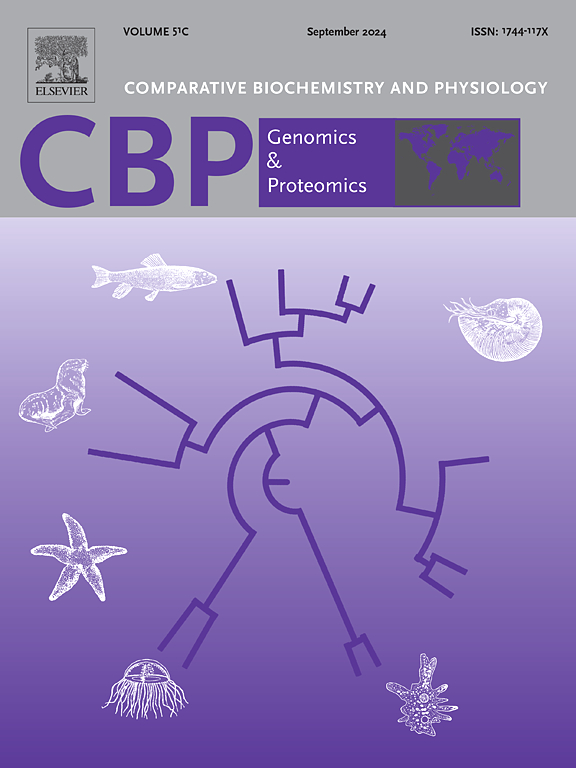Identification of sex-related genes across bivalves reveals key genes in gonad development and sex reversal
IF 2.2
2区 生物学
Q4 BIOCHEMISTRY & MOLECULAR BIOLOGY
Comparative Biochemistry and Physiology D-Genomics & Proteomics
Pub Date : 2025-04-01
DOI:10.1016/j.cbd.2025.101506
引用次数: 0
Abstract
The complex and diverse sexual reproduction patterns and multiple sex types of mollusks make it important to elucidate their sex mechanisms. Recent studies have demonstrated the crucial roles of Dmrt, STAT, and Sox genes in animal sex determination/differentiation. However, the comprehensive comparison of these genes in different bivalves is limited. In this study, 33 bivalves were analyzed to investigate the sequence characteristics, phylogenetic relationships, and expression profiles of these genes. Total of 112 Dmrt genes, 88 STAT genes and 229 Sox genes were identified in 33 bivalves. Phylogenetic analysis grouped the Dmrt, STAT, and Sox genes into 4, 3, and 7 groups, respectively. By comparing gene family number and sequence differences, we observed expansion and contraction in the Dmrt and STAT family genes, as well as sequence variations in Dmrt-01 and SoxH among different bivalves, suggesting their molecular adaptations to diverse sexual mechanisms. Expression profiles of these genes in noble scallop Chlamys nobilis revealed that CnDmrt-01 and CnSox-07 (SoxH) is predominantly expressed in testis, suggesting their male-specific role in gonad development and maturation. A higher expression level of CnSox-01/03 (Sox-B1/C) in ovary suggest their essential role in ovary development. These genes also showed significantly higher expression level during sex reversal, suggesting their crucial roles in this process. Additionally, transcriptome data from other bivalves further support that the sexual expression patterns of Dmrt-01 and Sox-B1/C/H are conserved across most bivalves. The results of this study will provide insights into these sex-related genes and useful information to better understand mechanisms of gonad development and sex reversal in mollusc.

双壳类动物性别相关基因的鉴定揭示了性腺发育和性别逆转的关键基因
软体动物复杂多样的有性繁殖方式和多种性别类型使得阐明其性别机制具有重要意义。最近的研究表明,Dmrt、STAT和Sox基因在动物性别决定/分化中起着至关重要的作用。然而,这些基因在不同双壳类动物中的综合比较是有限的。本文分析了33种双壳类动物的基因序列特征、系统发育关系和表达谱。在33种双壳类动物中共鉴定出112个Dmrt基因、88个STAT基因和229个Sox基因。系统发育分析将Dmrt、STAT和Sox基因分别分为4、3和7组。通过比较基因家族数量和序列差异,我们观察到不同双壳类动物Dmrt和STAT家族基因的扩增和收缩,以及Dmrt-01和SoxH基因的序列差异,表明它们对不同性别机制的分子适应。这些基因在贵族扇贝Chlamys nobilis中的表达谱显示,CnDmrt-01和CnSox-07 (SoxH)主要在睾丸中表达,表明它们在性腺发育和成熟中具有雄性特异性作用。CnSox-01/03 (Sox-B1/C)在卵巢中的高表达表明其在卵巢发育中起重要作用。这些基因在性逆转过程中也表现出显著的高表达水平,表明它们在这一过程中起着至关重要的作用。此外,来自其他双壳类的转录组数据进一步支持Dmrt-01和Sox-B1/C/H的性表达模式在大多数双壳类中是保守的。本研究结果将为进一步了解软体动物性腺发育和性别逆转的机制提供有用的信息。
本文章由计算机程序翻译,如有差异,请以英文原文为准。
求助全文
约1分钟内获得全文
求助全文
来源期刊
CiteScore
5.10
自引率
3.30%
发文量
69
审稿时长
33 days
期刊介绍:
Comparative Biochemistry & Physiology (CBP) publishes papers in comparative, environmental and evolutionary physiology.
Part D: Genomics and Proteomics (CBPD), focuses on “omics” approaches to physiology, including comparative and functional genomics, metagenomics, transcriptomics, proteomics, metabolomics, and lipidomics. Most studies employ “omics” and/or system biology to test specific hypotheses about molecular and biochemical mechanisms underlying physiological responses to the environment. We encourage papers that address fundamental questions in comparative physiology and biochemistry rather than studies with a focus that is purely technical, methodological or descriptive in nature.

 求助内容:
求助内容: 应助结果提醒方式:
应助结果提醒方式:


